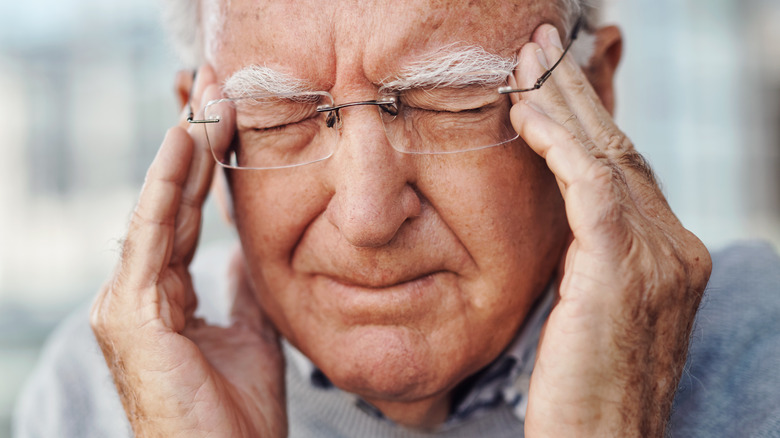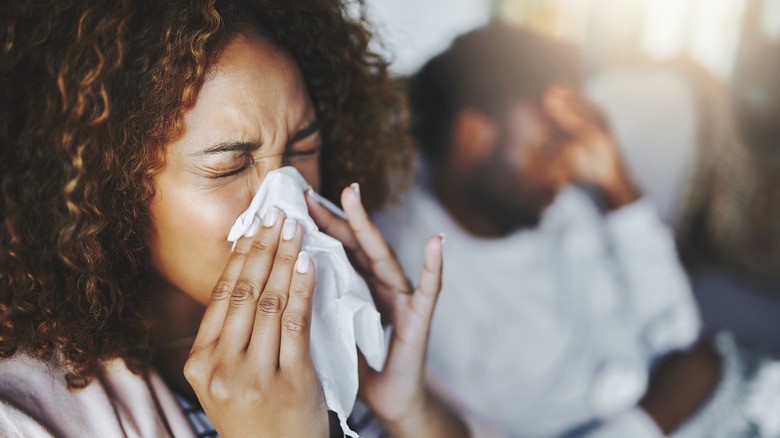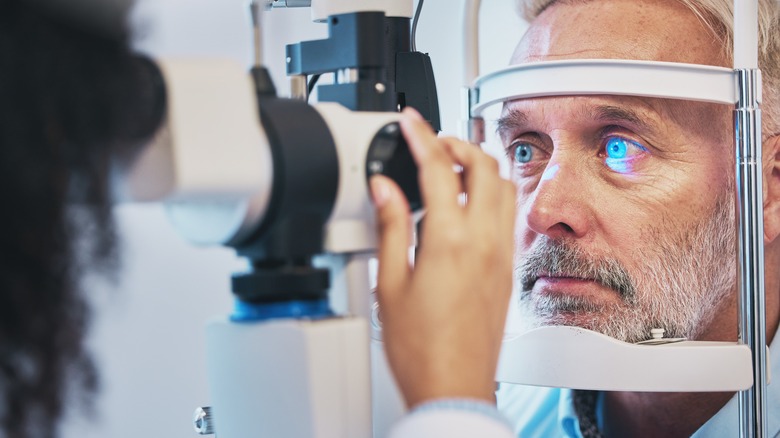What It Means When You Have Pain In Your Eyebrows
It's not abnormal to occasionally feel a bit of pain in your eyebrow. For example, knocking your head against a cabinet door could injure the area. It could also be a minor skin irritation, causing your eyebrow to throb slightly. Some people may also have pimples or an infection near the eyebrow, leading to pain. These types of injuries and infections typically come with a little lump under the skin or other indications of inflammation of the tissue.
However, when you're feeling pain in your eyebrow that's recurrent or doesn't come with any indication of an infection, it might be something under the eyebrow that's to blame. The frontalis muscles are found above your eyebrow and work to make it go up, per StatPearls. The corrugator muscle and a few other muscles work to make your eyebrows go down. These different muscles are also connected to the scalp and neck muscles. Hence, something that affects one muscle might make your eyebrow pulse, like a tension headache. Your sinuses are just above the brow, so an infection can cause pain. Additionally, eye problems, nerve pain, and inflamed arteries affect the area of the brows.
Here are some conditions that may affect the underlying structures of the eyebrows, and how they can cause your eyebrow to throb.
Eyebrow pain comes from tension headaches
You've been having a stressful week at work. By the end of the day, you notice that your eyebrows are killing you. There is also this band of tightness around your head that you can't seem to work out. When you're feeling this dull throbbing in your eyebrows, a tension headache is usually to blame.
Tension headaches aren't debilitating headaches like migraines, but they can be annoying, and it may be hard to pinpoint where the pain is coming from, per MedlinePlus. These headaches are associated with tension in your head and scalp muscles from injury, emotions, and stress. Symptoms include a feeling of tightness on the scalp and face, tenderness in the shoulders, neck, and face, and dull overall pain, states the Mayo Clinic. You might also find that you have episodic headaches, which occur sporadically, or chronic headaches, which happen often (15 days or more a month for three months). Unlike migraines, tension headaches don't cause visual disturbances or vomiting.
Try a yoga facial massage to help relieve the tension in the facial muscles for headache relief. While keeping your forehead in place with your left hand, use your right knuckle and fingertips to massage the right side of your forehead (via PopSugar). Tap between your brows and use face tape to keep the muscles relaxed.
Sinus infection brings on brow pain
The cold you've been dealing with for the last week or two has morphed into something more sinister, causing inflammation and blockage in the nasal cavity. As the bacteria grows, it becomes a full-out sinus infection, according to the Centers for Disease Control and Prevention (CDC). In addition to throbbing pain in the brow area, you'll experience a stuffy nose, facial pressure, headache, sore throat, and possibly even bad breath.
A sinus infection can be diagnosed after a healthcare professional looks at your symptoms, according to the American College of Allergy, Asthma, & Immunology (ACAAI). A culture, CT, or biopsy might even be ordered for those who suffer from chronic sinus infections. This type of sinus infection might be due to a fungus that can be dangerous if it finds its way into the bones.
Treatment includes getting rid of the bacteria that's causing the infection through a course of antibiotics. Take decongestants and over-the-counter medications to help alleviate the pain and pressure in the sinus cavity. The ACAAI also notes that antihistamines, topical nasal corticosteroids, and saline washes can help. In severe cases, surgery fixes any defects in the nasal cavity.
Brow pain comes with shingles
You've probably heard of the chickenpox virus. As a kid, you might have even experienced the virus that causes an itchy rash all over your body. Even with a vaccine, mild cases of chickenpox can happen. Once that virus has entered your body, it never leaves (per the CDC). Years later, the virus can reactivate in your body, giving you a painful condition called shingles. Therefore, this condition is typically seen in those who are over the age of 50.
Per NHS Inform, shingles are an infection of the nerve and skin. It can cause you to feel a headache near your eyebrow. More commonly, it causes a painful rash that is similar to chickenpox. This rash develops around the affected nerve, and new blisters can appear for up to a week. Since shingles affect the nerve, pain is felt around the area of the sores, which can be stabbing at times. People with this condition may also feel sick and experience itchiness.
When shingles are suspected, antiviral medications can help make healing easier. Since the pain can be severe, the Mayo Clinic states that pain medication and patches might be prescribed to help numb the area. You can also get a vaccine to help prevent shingles in the first place if you're at a higher risk for developing them.
Sufferers of glaucoma experience eyebrow pain
Glaucoma might bring to mind simply losing visual acuity, but this chronic, progressive disease comes with pain and pressure. According to Johns Hopkins Medicine, glaucoma is known as the silent blinder because the early stages have no noticeable symptoms. This disease leads to an abnormality in the eye's drainage system, so the fluid can't filter out as it should, leading to pressure on the optic nerve and damage.
Symptoms of glaucoma develop slowly, per the American Academy of Ophthalmology. With open-angle glaucoma, small blind spots develop in the peripheral vision. Without regular eye exams, the progression can be missed until it advances. Angle-closure glaucoma includes attacks with symptoms of pain in the forehead, redness in the eye, blurred vision, rainbows, or halos. This is due to the iris blocking the drainage closure. Tension glaucoma includes regular pressure readings, but also blind spots and optic nerve damage.
Having risk factors for glaucoma can make you more susceptible to the disease. For example, having a family history, being over 40, being nearsighted or farsighted, having diabetes or migraines, and having high blood pressure put you at higher risk. Treatment includes medications to lower the eye pressure, laser eye treatment to drain fluid, and surgery to open the drainage hole, per the National Eye Institute.
Temporal arteritis causes eyebrow pain
Your facial muscles have different vessels that supply them with blood. When something goes wrong with the blood supply, pain is typically a result.
Eyebrow pain can be a symptom of giant cell arteritis, which is inflammation of the blood vessels in the neck, face, and upper body. It's also known as temporal arteritis, according to Penn Medicine. The narrowing of the temple arteries causes headaches, jaw pain, vision problems, muscle aches, and tenderness near the eyebrows and temple. Per the Cleveland Clinic, fever and fatigue can accompany this condition.
The cause of this disease is hard to ascertain, but it could be due to an autoimmune response by the body. Additionally, it's known to occur in those diagnosed with polymyalgia rheumatica, an inflammatory disorder leading to muscle stiffness (via the National Institute of Arthritis and Musculoskeletal and Skin Diseases).
This condition can't be cured, so treating the symptoms is critical to improving the quality of life. Therefore, steroids might be administered to help with the inflammation. Other medications are also available as well. The Cleveland Clinic also notes that smoking and drinking need to be kept to a minimum. Adding exercise to your daily routine and taking vitamins can also limit the effects of the condition.






